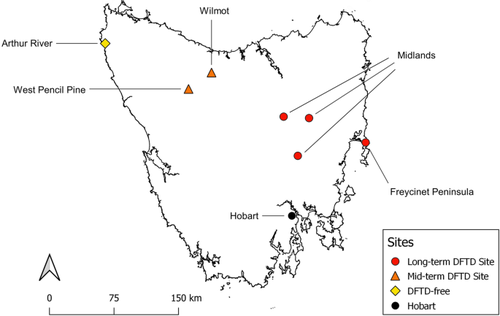Oecologia ( IF 2.7 ) Pub Date : 2024-04-15 , DOI: 10.1007/s00442-024-05544-9 Olivia Bell , Menna E. Jones , Manuel Ruiz-Aravena , David G. Hamilton , Sebastien Comte , Rowena Hamer , Rodrigo K. Hamede , Jason Newton , Stuart Bearhop , Robbie A. McDonald

|
Top carnivores can influence the structure of ecological communities, primarily through competition and predation; however, communities are also influenced by bottom-up forces such as anthropogenic habitat disturbance. Top carnivore declines will likely alter competitive dynamics within and amongst sympatric carnivore species. Increasing intraspecific competition is generally predicted to drive niche expansion and/or individual specialisation, while interspecific competition tends to constrain niches. Using stable isotope analysis of whiskers, we studied the effects of Tasmanian devil Sarcophilus harrisii declines upon the population- and individual-level isotopic niches of Tasmanian devils and sympatric spotted-tailed quolls Dasyurus maculatus subsp. maculatus. We investigated whether time since the onset of devil decline (a proxy for severity of decline) and landscape characteristics affected the isotopic niche breadth and overlap of devil and quoll populations. We quantified individual isotopic niche breadth for a subset of Tasmanian devils and spotted-tailed quolls and assessed whether between-site population niche variation was driven by individual-level specialisation. Tasmanian devils and spotted-tailed quolls demonstrated smaller population-level isotopic niche breadths with increasing human-modified habitat, while time since the onset of devil decline had no effect on population-level niche breadth or interspecific niche overlap. Individual isotopic niche breadths of Tasmanian devils and spotted-tailed quolls were narrower in human-modified landscapes, likely driving population isotopic niche contraction, however, the degree of individuals’ specialisation relative to one another remained constant. Our results suggest that across varied landscapes, mammalian carnivore niches can be more sensitive to the bottom-up forces of anthropogenic habitat disturbance than to the top-down effects of top carnivore decline.
中文翻译:

人类栖息地的改变,而不是顶级食腐动物的减少,导致了食肉动物群落中同位素生态位的变化
顶级食肉动物可以影响生态群落的结构,主要通过竞争和捕食;然而,社区也受到自下而上的力量的影响,例如人为栖息地干扰。顶级食肉动物的减少可能会改变同域食肉动物物种内部和之间的竞争动态。通常预计种内竞争的加剧将推动利基扩张和/或个体专业化,而种间竞争往往会限制利基。利用晶须的稳定同位素分析,我们研究了塔斯马尼亚恶魔Sarcophilus harrisii下降对塔斯马尼亚恶魔和同域斑尾袋鼬Dasyurus maculatus subsp.种群和个体水平同位素生态位的影响。斑纹。我们调查了袋獾衰退开始以来的时间(代表衰退严重程度)和景观特征是否影响袋獾和袋鼬种群的同位素生态位宽度和重叠。我们量化了塔斯马尼亚袋獾和斑尾袋鼬的个体同位素生态位宽度,并评估了地点之间种群生态位的变化是否是由个体水平的专业化驱动的。随着人类改造栖息地的增加,塔斯马尼亚袋獾和斑尾袋鼬表现出较小的种群水平同位素生态位宽度,而袋獾数量下降开始后的时间对种群水平生态位宽度或种间生态位重叠没有影响。在人类改造的景观中,塔斯马尼亚袋獾和斑尾袋鼬的个体同位素生态位宽度变窄,可能导致种群同位素生态位收缩,然而,个体相对于彼此的专业化程度保持不变。我们的研究结果表明,在不同的景观中,哺乳动物食肉动物生态位对人为栖息地干扰的自下而上的力量比对顶级食肉动物衰退的自上而下的影响更敏感。



























 京公网安备 11010802027423号
京公网安备 11010802027423号